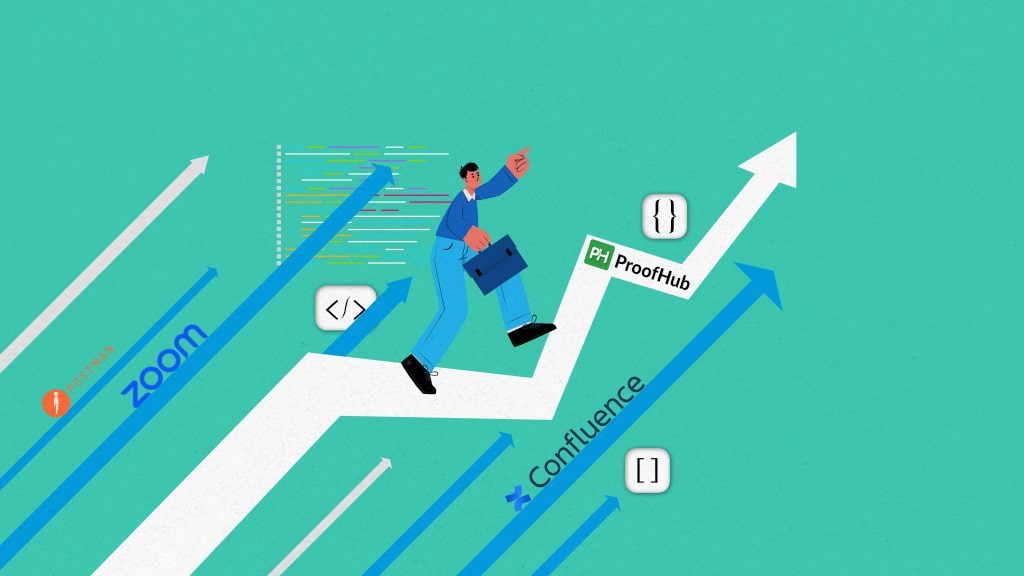Introduction
Productivity tools for developers play a crucial role in the modern software development landscape. Software developers on average use 8 to 10 different tools to build great software, according to a survey by Statista. The purpose of all these tools is to improve productivity and make it easy to work on the tasks involved at various stages of the software development cycle (SDLC).
75% of global organizations use productivity tools to improve productivity.
Whether it is coding, debugging, testing, deployment, bug tracking, or project management, there are dedicated tools to perform every job function.
In this post, we will look at the top 12 productivity tools for developers in 2026, covering productivity and usability in almost all the job functions of SDLC. This list will be a good starting point for your productivity journey.
Top 12 productivity tools for developers in 2026
Based on hours of research, discussions with software developers and SMEs in our organization, real users’ reviews, and free trials, I have created this comprehensive list of the best productivity tools for developers.
I have listed the key features, pros, and cons of the tool and also mentioned in which category the listed tool is the best. It will help you find the key information in one place to make the right decision.
1. ProofHub – Best for project management
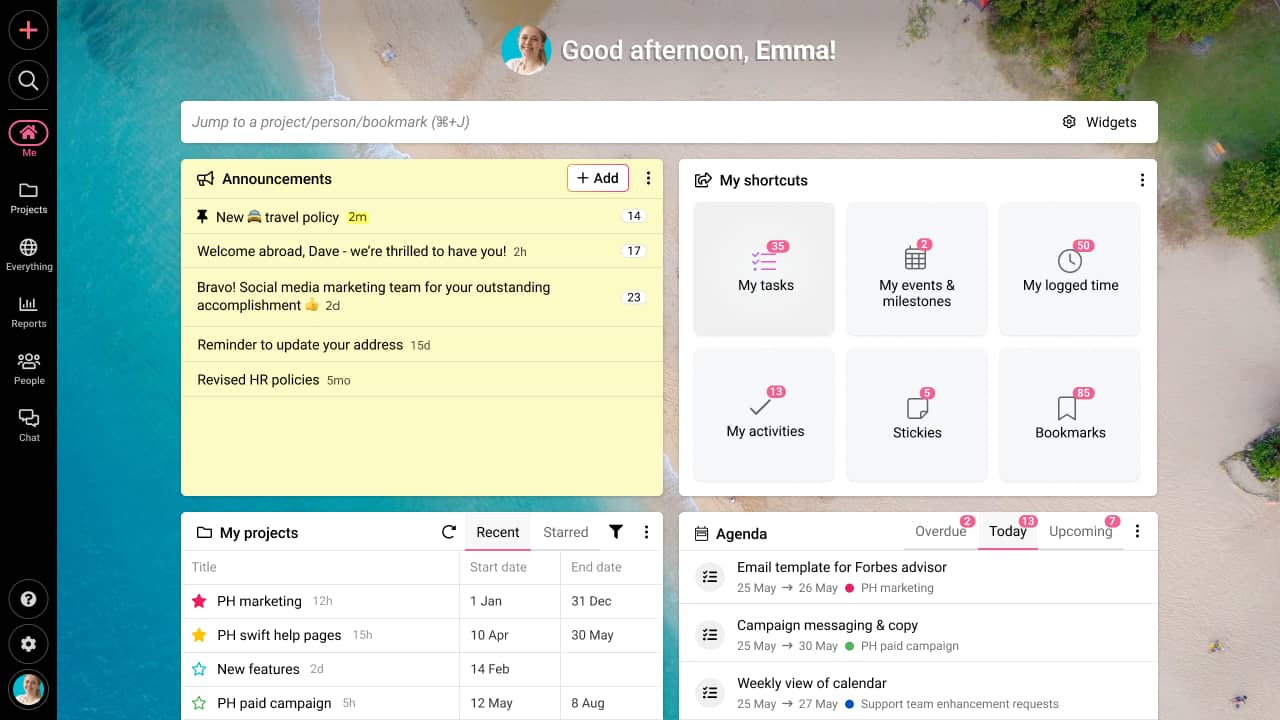
ProofHub is one of the best productivity tools for developers to manage software development projects. It helps you streamline workflows, visualize all the tasks, and collaborate with the team from a centralized place.
The platform focuses on improving productivity by bringing all the projects, team communication, and teamwork into one place. This enhanced organization of all the tasks and resources ensures you stay on top of your projects and work together efficiently.
ProofHub is a feature-rich tool that provides you with a diverse set of features to replace multiple apps with one app for work management.
Key features
- Centralized task management to create, delegate, and track tasks from one place.
- Task ID to keep track of each user story and bugs.
- Multiple task assignees, subtasks, due dates, labels, automatic timers, file attachments, and task comments to collaborate on tasks from one place.
- Custom fields to capture the desired information in tasks.
- Custom workflows to help you create a customized workflow.
- Create a project plan and set task dependencies with GanttChart.
- Kanban View and Table View to visualize all the tasks at a glance.
- Calendar to visualize resource workload and schedule meetings with the team.
- Time tracking to find out how much time you are spending on each task and timesheets to log the billable and non-billable hours.
- Overview of the project progress with reports.
- In-built team chats to communicate with the team frictionlessly.
- Discussions at project levels to engage clients in projects.
- Forms to collect clients’ requirements.
Pros
- ProofHub is easy to use with an intuitive UI
- A minimal learning curve makes sure your team can easily adopt the solution
- Unlimited users can use the tool for a flat fee, making it a budget-suitable solution
- Replaces multiple apps with one app making it ideal for businesses of all sizes
Cons
- Not suitable for single users or freelancers
- Notifications can often feel overwhelming
Pricing
ProofHub offers two plans: Essential and ultimate control
- Essential: $45/month for unlimited users and up to 40 projects when billed annually.
- Ultimate Control: $89/month for unlimited users, unlimited projects, and all the premium features when billed annually
You get a 14-day free trial to try all the premium features of ProofHub!
User ratings
- G2 – 4.5 out of 5 stars
- Capterra – 4.6 out of 5 stars
2. GitHub – Best for code storage and version control

GitHub is the most popular and reliable cloud-based code repository that helps you store, share, and collaborate on code. As one of the essential developer tools to increase your productivity, it allows you to track and manage changes with version control; reducing the manual efforts of using commands to track changes. With simple version control, you can see and track ‘who’ made the ‘what’ changes.
The newest addition to the suite of products by GitHub to improve developers’ productivity is GitHub Co-pilot. It helps you with smart suggestions to accelerate the pace of coding. GitHub is indeed one of the essential tools for productivity in software development.
Key features
- Simply pull and push the files to collaborate on code with the team.
- Code review for version control, tracking the code changes, and merging the changes.
- Built-in CI/CD capabilities to deploy software.
- Workflow automation to automate your build, test, and deployment workflow.
- GitHub Copilot to write better code with AI.
Pros
- A beginner-friendly and easy-to-use tool
- Advanced security to collaborate on code in secured environments
- Integrate with a wide suite of developers’ apps
Cons
- Takes time to master the use of GitHub
- Some advanced security features are reserved only for enterprise plans
Pricing
Scoro offers three plans
- Free: Limited to 500 MB of package storage
- Team: $4 per user per month
- Enterprise: $21 per user per month
User ratings
- Capetera: 4.8 out of 5 stars
- G2: 4.7 out of 5 stars
Website link: Github.com
3. Visual Studio Code – Best for code writing and editing
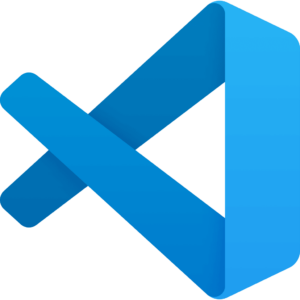
Visual Studio Code by Microsoft is one of the top productivity tools for software development, offering an intuitive code editor to help developers write and edit code faster. It provides you with features like syntax highlighting and autocomplete. The tool allows you to search within the code and debug the code right from the editor.
The recent collaboration with GitHub Copilot has revolutionized developers’ productivity. The AI pair programmer helps users complete tasks faster with the help of multi-line suggestions prompted by your code and code comments. This saves time and allows developers to focus more on the logic than code writing.
Key features
- Syntax highlighting and autocomplete with IntelliSense.
- Debug code right from the editor.
- Built-in support for JavaScript, TypeScript, and Node.js.
- Comes with Git commands built-in and integrates with other SCM providers.
Pros
- The interface is easy to use and the layout is clean
- Available for Windows, macOS, and Linux
- Extensible and customizable to add new languages such as C++, C#, Java, Python, PHP, Go, and .NET
Cons
- Sometimes it is laggy
- Difficult for newbies to learn
- Relies on plugins for advanced features
Pricing
Visual Studio Code is free for private or commercial use.
User ratings
- Capetera: 4.8 out of 5 stars.
- G2: 4.7 out of 5 stars.
Website link: visualstudio.microsoft.com
4. Postman – Best for testing

Postman is the fastest API testing tool, and it is used by over 30 million developers to build APIs. It provides you with a comprehensive set of tools to create, import, and export multiple APIs easily. The platform focuses on improving productivity by simplifying each step of the API lifecycle and streamlining collaboration so that you can create better APIs faster.
Key features
- Postman API client to easily explore, debug, and test your APIs.
- API design to design your API specifications using OpenAPI, RAML, GraphQL, or SOAP formats.
- API testing to create, build, and run tests directly in Postman.
- Mock servers enable you to see exactly how your API will run.
- A cloud-based, version-controlled, centralized repository for all API artifacts.
Pros
- Define complex API requests for HTTP, REST, SOAP, GraphQL, and WebSockets
- User-friendly and intuitive interface
- Built-in support for authentication protocols like OAuth 1.2/2.0, AWS Signature, Hawk, and many more
Cons
- Sometimes app crashes when working on large collections
- Help resources and customer support can be improved
Pricing
Apart from the free plan, Postman offers three other plans:
- Basic: $14 per user per month, billed annually
- Professional: $29 per user per month, billed annually
- Enterprise: $49 per user per month, billed annually
User ratings
- Capetera: 4.7 out of 5 stars
- G2: 4.6 out of 5 stars
Website link: Postman.com
5. Jenkins – Best for Continuous Integration and Continuous Delivery

Jenkins is a self-contained Java-based program that focuses on improving efficiency by automating the build, test, and deployment. You can save time and eliminate human errors with automated code integration and deployment. All you need to do is just write down the instructions. The tool can be used as a simple CI server or turned into a continuous delivery hub for any project with automation capabilities.
Key features
- Built-in CI/CD capabilities.
- Support over 1500 plugins to extend its functionalities.
- Deploy all changes in one go on multiple platforms.
- Packages for multiple operating systems like Windows, Linux, and macOS.
Pros
- Open-source, free, and secure app
- Easy to set up and configure
- Integrates with practically every tool in the continuous integration and continuous delivery toolchain
Cons
- Comes with a learning curve. Not beginner-friendly
- Thin customer support. Relies on the community for a solution
- Lack of native containerization features
Pricing
Jenkins is an open-source free platform
User ratings
- Capetera: 4.5 out of 5 stars
- G2: 4.4 out of 5 stars
Website link: Jenkins.io
6. Chrome DevTools – Best debugging tool for javascript

Chrome DevTools is a productivity tool for web developers that helps you edit webpages on the fly and diagnose problems quickly. It provides you with the inspect element to analyze web page elements, determine page speeds, and provide optimization advice for SEO. You can use it to inspect and troubleshoot HTML, CSS, and JavaScript problems.
The only constraint with the debugging tool is that you need a different tool based on the language you use in coding. Thus, if your team works in multiple languages, you need a list of debugging tools.
Here are the most common debugging tools:
- ChromeDevTools for HTML, CSS, and Javascript
- WinDbg for Windows
- Eclipse for Java
- PyCharm for Python
- Xdebug PHP
Key features
- Inspect elements to explore the DOM, CSS, and JavaScript and see how changes affect the user experience.
- Multiple panels, including elements panel, console panel, source panel, network panel, performance panel, and more, are used to analyze the webpage.
- Community to file bug reports and feature requests in Crbug.
- Built directly into the Google Chrome browser.
Pros
- Various types of metrics provide in-depth insights
- You can use it right from your browser
Cons
- Limited debugging capabilities in native iOS or Android apps
- Used as a standalone tool
Pricing
Chrome DevTools is free to use
User ratings
- Capetera: 4.8 out of 5 stars
- G2: 4.4 out of 5 stars
Website link: Google dev tools
7. Datadog – Best for application monitoring
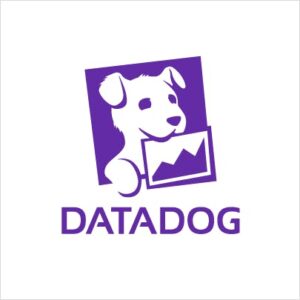
Resolving bugs is part of the life of any developer. To ensure an app is functioning optimally, software developers need to monitor the application’s performance. Datadog is the finest tool for application performance monitoring that helps you monitor, troubleshoot, and secure cloud-scale applications. With Datadog’s cloud-monitoring service, you can quickly detect the source of service issues and resolve incidents.
Key features
- Find the root cause of issues quickly by correlating traces with logs, infrastructure metrics, database queries, network calls, and frontend telemetry.
- Real-time visibility into the execution time and resource consumption of every method and code line.
- Track and alert on business-specific KPIs by creating dashboards, monitors, and SLOs from span-based metrics using any tag.
- Track every deployment, quickly determine if a release is causing high error rates or latency, and resolve performance degradations automatically.
Pros
- Can handle a large number of data logs
- Instantly notify of any issues
- Monitors data in the most efficient, accurate, and easy way
Cons
- Expensive solution for small IT shops
- Requires training to understand the graph reports
Pricing
Datadog has five plans:
- Free: Up to five hosts with limited functions
- Pro: $15 per user per month, billed annually
- Enterprise: $23 per user per month, billed annually
- DevSecOps Pro: $22 per user per month, billed annually
- DevSecOps Enterprise: $34 per user per month, billed annually
User ratings
- Capetera: 4.6 out of 5 stars
- G2: 4.3 out of 5 stars
Website link: Datadoghq.com
8. Confluence – Best for documentation and file management

Software documentation acts as a cornerstone for a software development project. Without the right documentation, it is hard to identify the project scope, plan the sprints appropriately, prioritize user stories, and engage with clients and teams. Confluence is one of the oldest apps used for technical documentation for software development projects. It helps you with real-time co-editing and commenting. You can track the changes with version history.
The best thing about Confluence is the organization of the documents, which makes it easy for everyone to find information. It focuses on improving productivity by bringing all the documents to one place.
Key features
- Insert notes, tables, Figma embeds, Google Docs files, and more in Pages to create content quickly and easily.
- Spaces for individuals and teams to view project documents in one place.
- Permissions to protect sensitive content.
- Version history to track changes and comments to collaborate.
- Advanced search to organize and find pages easily and create an intuitive content hierarchy with a content tree.
Pros
- Power of AI to help you write your first draft
- Pre-built templates to get started quickly
- Integration with other third-party apps flawlessly
Cons
- Some features are reserved only for the top-tier paid plans
- The user interface can be made more intuitive
Pricing
Confluence offers free, standard, and premium plans.
- Free plan: Allows up to 10 users
- Standard plan: Starts at $5.16 per user per month
- Premium plan: Starts at $9.73 per user per month
- Enterprise: Contact sales
- Data Center: Starts at $28,000 per year for 500 users
User ratings
- Capetera: 4.5 out of 5 stars
- G2: 4.1 out of 5 stars
Website link: Confluence
9. Figma – Best for wireframing
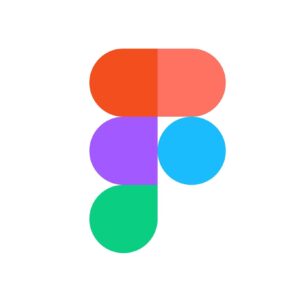
Every developer needs to know how the app should look in a real environment before starting full-scale development. Figma is a popular tool for website and app wireframing for UX designers. It allows you to create wireframes and realistic prototypes. You can manage your design system from a centralized place with Figma.
Key features
- Wireframing to communicate your ideas visually.
- Create prototypes to bring designs to life before development.
- Create vectors, adjust layers in layout, customize type, and variable fonts on a canvas to create anything.
- Figam DevMode provides you with tools to help you translate designs into code faster.
Pros
- Supports both wireframing & prototyping
- Design simple and complex user interfaces without using a single code
- Advanced collaboration capabilities, such as sharing wireframes with a simple shareable link
Cons
- The learning curve is a little high compared to other similar software
- Some features are reserved only for paid plans
Pricing
Figma has four plans.
- Starter: free up to three collaborative design files
- Professional: $15 per user per month, billed annually
- Organization: $45 per user per month, billed annually
- Enterprise: $75 per user per month, billed annually
User ratings
- Capetera: 4.7 out of 5 stars.
- G2: 4.7 out of 5 stars.
Website link: Figma.com
10. Zoom – Best for whiteboarding and remote collaboration

Software development is a team effort that goes through a multi-step process. Therefore, developers need to share the information. Zoom, known as one of the best productivity tools for developers, is the best video conferencing and whiteboard app for developers to stay connected and share information. Especially in remote working environments, you need powerful video conferencing to facilitate daily stand-up meetings and share information to work productively.
When considering productivity tools for work, Zoom stands out for its ability to enhance collaboration and communication among developers.
Key features
- HD video and audio conferencing with support for up to 1000 video participants.
- Record your virtual meetings locally or to the cloud, with searchable transcripts.
- Advanced whiteboarding tools to collaborate whenever and wherever you want on any device.
- Zoom Scheduler to share your availability and book appointments.
- All collaboration tools are under one roof, including Zoom mail, Zoom Calendar, Zoom Meetings, Zoom Chat, Zoom Whiteboards, and more.
Pros
- Easy to use and connect
- Screensharing during meetings
- Support Android, iPhone, Mac, iPad, and web platforms
Cons
- Poor customer support
- Data privacy concerns as the company is owned overseas
Pricing
Zoom offers five plans for ZoomOne
- Basic: Free with limits on features
- Pro: $13.32 per user per month billed annually
- Business: $18.32 per user per month billed annually
- Business Plus: $22.49 per user per month billed annually
User ratings
- Capetera: 4.6 out of 5 stars.
- G2: 4.5 out of 5 stars.
Website link: Zoom
11. Brain.fm – Best for building focus with science-based music

The connection between developers’ focus and music is well-known. Brain.fm is the best focus music app backed by science that aims to improve your attention with music made to help you work better. It stimulates the brain with gentle, rhythmic pulses that support sustained attention. The USP of the brand is that other music is made to grab your attention but Brain.fm’s functional music is designed to optimize your performance.
Key features
- Four music modes: Focus, Relax, Meditate, and Sleep.
- Build focus in five minutes with sound waves designed based on the principle of neural phase locking.
- Music library to choose the music that works best for you.
- Timer to set the duration you want to hear music.
Pros
- Easy to use. Simply click on the button and your focus music is ready
- Available for Android, iOS, and web
- Positive brand image. Users reported improvements in focus
Cons
- It is not a free app though you can try it for free
- Expensive monthly plan
Pricing
Brain.fm offers two plans:
- Monthly: $9.99 /month Unlimited access to Brain.fm for a month
- Yearly: $69.99 /month Unlimited access to Brain.fm for 12 months
Annual subscriptions are backed by our 60-day money-back guarantee.
User ratings
- Capetera: NA
- G2: NA
Website link: Brain.fm
12. Weblium – Best for Website Building with AI Features

Building a website can be a daunting task, especially when it comes to ensuring it performs optimally. Weblium is the finest tool for website building, offering AI-driven features to help you create, design, and optimize your website effortlessly. With Weblium’s AI-powered website builder, you can easily design professional websites and content, including text and images.
Key Features
- AI Writing and AI Visual tools to generate high-quality content and stunning visuals effortlessly with Weblium’s AI-powered tools, saving you time and ensuring professional results.
- AI design assistance to make your website look professionally designed and trendy.
- Wide range of flexible and customizable templates, ensuring your website aligns with your brand.
- Integration with Figma to import your website designs directly into Weblium.
- Real-time performance monitoring to have real-time analytics and insights to ensure it runs smoothly.
- User-friendly interface accessible for users of all skill levels.
Pros
- 300+ free website templates
- AI-driven content and design tools
- Easy-to-use interface functionality
- Responsive designs that work on all devices
Cons
- Limited advanced customization for experienced developers
- Basic blog feature
Pricing
Weblium offers just one paid plan:
- Free: Basic features to get you started
- Pro: $8.25 per month, billed annually
User ratings
- Capterra: 4.8 out of 5 stars
- G2: 4.8 out of 5 stars
Website link: Weblium.com
Additional developer productivity tools improve productivity
Have a look at the other additional tools that may help developers improve their productivity.
- Sourcegraph: Sourcegraph is a code search tool that helps you rapidly search the code. It can be installed into your code editor to make it easy to find the exact code lines you are looking for.
- Jam: Jam is an easy-to-use bug tracker and reporting tool that automatically creates a bug report with all the info engineers need. It includes console logs, network requests, browser info, device details, repro steps, comments, and more. It integrates with your existing stack to report and resolve bugs quickly.
- Slack: Slack is a popular communication tool that focuses on improving productivity by bringing team chat and teamwork into one place. It provides you with organized spaces for everyone and everything that you need for work.
- Notion: Notion is a popular note-taking and content-creation app that helps you bring all of your company knowledge to one place with the help of centralized Wikis. It integrates with a large number of apps.
- SaneBox: If you spend too much time in your email inbox, SaneBox is a tool to help you remain sane. It uses A.I. to identify important emails and automatically organizes them so that you can quickly check them and stay focused on your work.
Read more: Best productivity tools that will make your life much easier
Factors to consider while choosing a productivity tool for developers
You need to keep a few things in mind while choosing the best productivity tools for software developers because they can directly impact the workflow, efficiency, and even finances of the company. Here are the six factors to consider:
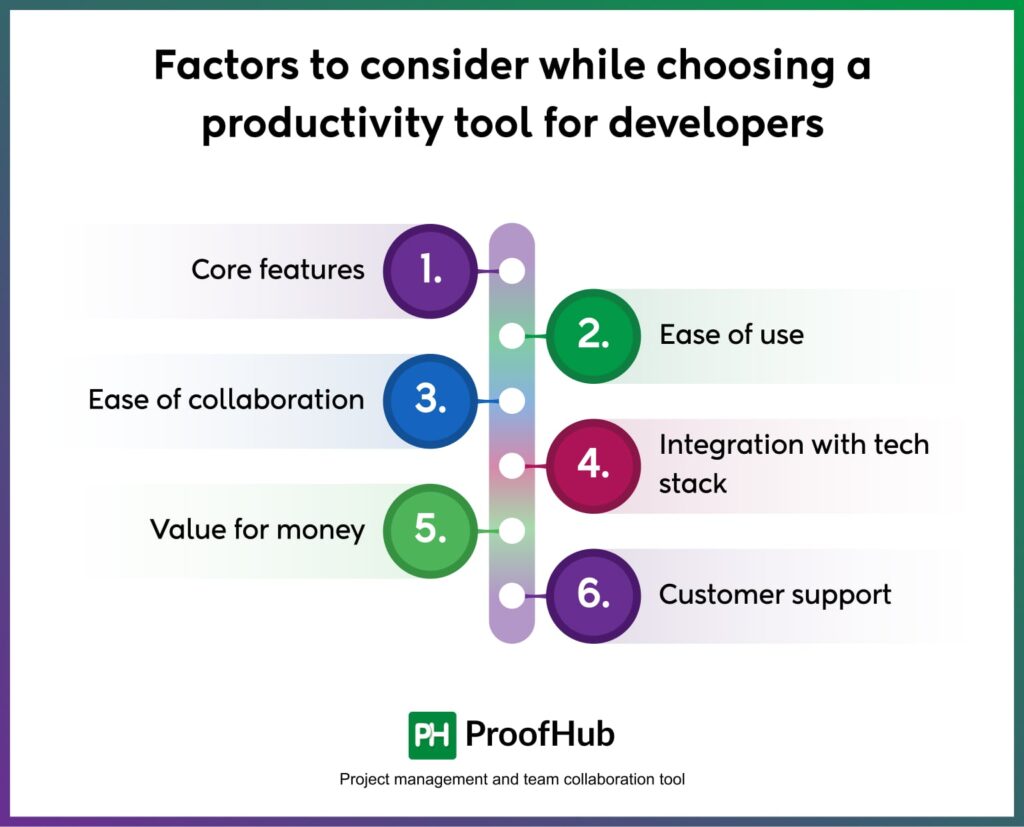
1. Core features
Whether you are looking for project management software, code editor, or some other developer’s productivity app, the tool must have a core set of features to perform the specific job function easily and efficiently with minimal effort.
To prepare the comprehensive list of features you need in a tool, involve team members and stakeholders in the process and segment the features into categories like ‘must-have’, ‘love to have’, and ‘not required’.
2. Ease of use
A tool should be easy to use so that users are not struggling every day to figure out how to use it. If a tool has a complex user interface and a huge learning curve, it will be more of a bump to productivity rather than a launchpad. Look for a tool with an intuitive interface and minimal learning curve.
3. Ease of collaboration
Irrespective of your chosen category, the software should have decent collaboration capabilities. The capabilities may vary. For instance, you may need a chat, file sharing, and task comments in a project management software, whereas, for a code repository, you may need version control, cloud-sharing, and co-editing.
But you need collaboration capabilities to work with your team members from anywhere effortlessly.
4. Integration with tech stack
Your productivity tool must be compatible with your tech stack. It is because developers use multiple tools and they would love to have all the tools in one place so that they do not have to switch between apps. Choose a tool that integrates with the third-party apps your team uses.
5. Value for money
Productivity tools for software developers are filled with open-source and free software, but it does not mean they are valuable. In fact, a poor tool can cost you money, irrespective of whether it is paid or free. Therefore, carefully evaluate the benefits of each tool and the value you get out of your investment.
This approach also helps in situations where you are confused between choosing the two tools offering the same features. You pick the tool that offers you the best value for money. Take into account factors like per-user pricing, features in the plan, and customer support to make a better decision.
6. Customer support
Customer support plays a big role when choosing software because you need it at every step whether it is onboarding for training, during the use for resolving bugs, and even at the end of the tool life cycle if you want to migrate to another tool. Find a company that provides 24/7 support in your language so that you can get issues resolved faster.
I hope these suggestions help you choose the right productivity tools for developers.
Conclusion
It is no secret that tools help you improve productivity, make work life easy, and facilitate you to work together. For every type of task in a software development project, there is software to help you. So, there is no need to waste time on manual efforts.
A productivity tool is a worthy investment in your business. The only question left is that you need to find the right tools to increase developer productivity as per your organizational needs. It is because a productivity tool should make their lives easy and not become a roadblock to productivity.
If you are looking for better ways to manage software projects and team collaboration, ProofHub is the ultimate productivity tool to bring projects, teamwork, and team communication to one place to improve productivity.
Read more similar articles:
- 43 productivity tools that will make your life much easier
- Top 10 software development project management tools 2026
- Top 16 Software Development Tools in 2026 (with In-depth Review)
FAQs
What are software productivity tools?
Software productivity tools are the software that helps developers improve productivity by making it easy to work on day-to-day tasks. A software productivity tool focuses on saving time. It provides you with features that reduce manual efforts.
How do you measure developer productivity?
Measuring a developer’s productivity is not simple. It is because development work is complex and multifaceted. Still, there are some frameworks and metrics that can help you measure developer productivity. These include DORA, Space, and Cycle time.
What are the 3 major productivity tools?
Three major types of productivity tools include project management, document management, and team collaboration. However, a developer needs job-specific productivity tools also to work efficiently.
